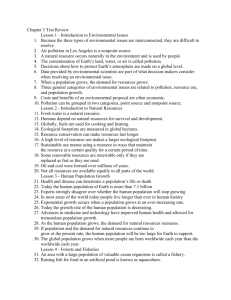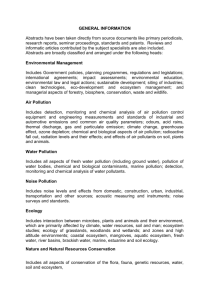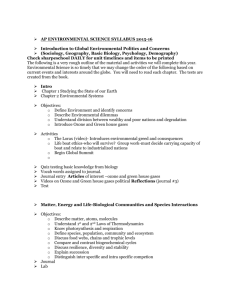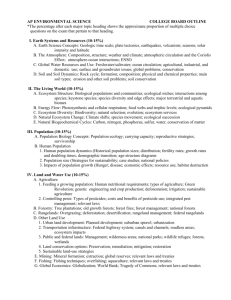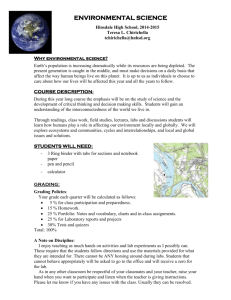APES Syllabus 2015-2016
advertisement
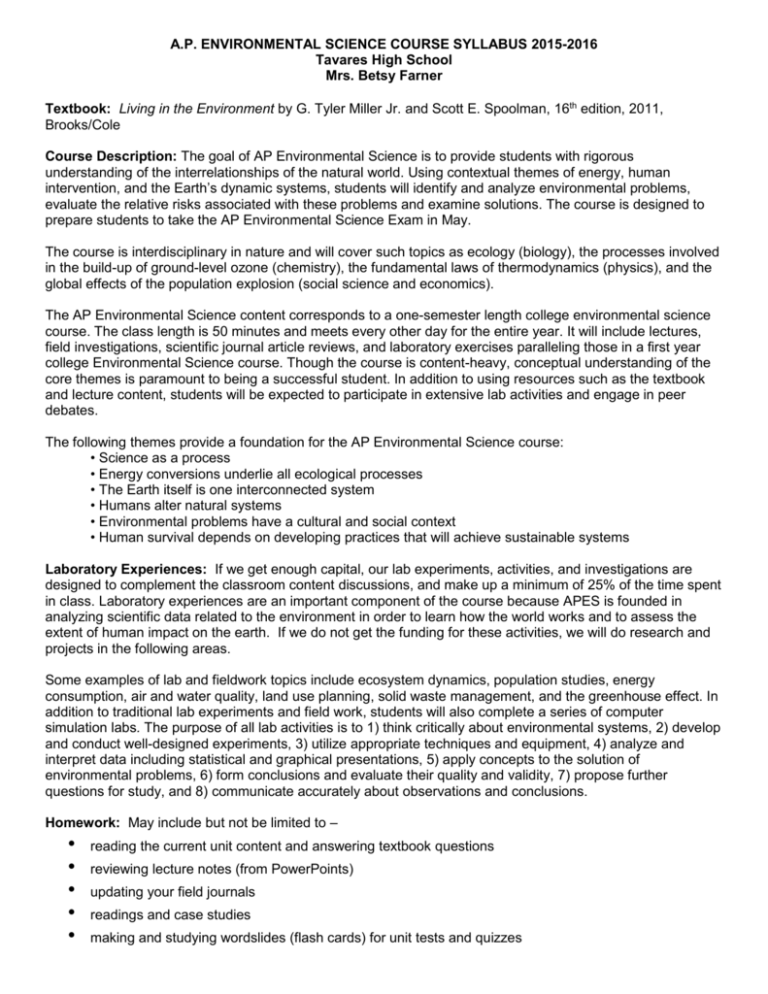
A.P. ENVIRONMENTAL SCIENCE COURSE SYLLABUS 2015-2016 Tavares High School Mrs. Betsy Farner Textbook: Living in the Environment by G. Tyler Miller Jr. and Scott E. Spoolman, 16th edition, 2011, Brooks/Cole Course Description: The goal of AP Environmental Science is to provide students with rigorous understanding of the interrelationships of the natural world. Using contextual themes of energy, human intervention, and the Earth’s dynamic systems, students will identify and analyze environmental problems, evaluate the relative risks associated with these problems and examine solutions. The course is designed to prepare students to take the AP Environmental Science Exam in May. The course is interdisciplinary in nature and will cover such topics as ecology (biology), the processes involved in the build-up of ground-level ozone (chemistry), the fundamental laws of thermodynamics (physics), and the global effects of the population explosion (social science and economics). The AP Environmental Science content corresponds to a one-semester length college environmental science course. The class length is 50 minutes and meets every other day for the entire year. It will include lectures, field investigations, scientific journal article reviews, and laboratory exercises paralleling those in a first year college Environmental Science course. Though the course is content-heavy, conceptual understanding of the core themes is paramount to being a successful student. In addition to using resources such as the textbook and lecture content, students will be expected to participate in extensive lab activities and engage in peer debates. The following themes provide a foundation for the AP Environmental Science course: • Science as a process • Energy conversions underlie all ecological processes • The Earth itself is one interconnected system • Humans alter natural systems • Environmental problems have a cultural and social context • Human survival depends on developing practices that will achieve sustainable systems Laboratory Experiences: If we get enough capital, our lab experiments, activities, and investigations are designed to complement the classroom content discussions, and make up a minimum of 25% of the time spent in class. Laboratory experiences are an important component of the course because APES is founded in analyzing scientific data related to the environment in order to learn how the world works and to assess the extent of human impact on the earth. If we do not get the funding for these activities, we will do research and projects in the following areas. Some examples of lab and fieldwork topics include ecosystem dynamics, population studies, energy consumption, air and water quality, land use planning, solid waste management, and the greenhouse effect. In addition to traditional lab experiments and field work, students will also complete a series of computer simulation labs. The purpose of all lab activities is to 1) think critically about environmental systems, 2) develop and conduct well-designed experiments, 3) utilize appropriate techniques and equipment, 4) analyze and interpret data including statistical and graphical presentations, 5) apply concepts to the solution of environmental problems, 6) form conclusions and evaluate their quality and validity, 7) propose further questions for study, and 8) communicate accurately about observations and conclusions. Homework: May include but not be limited to – • • • • • reading the current unit content and answering textbook questions reviewing lecture notes (from PowerPoints) updating your field journals readings and case studies making and studying wordslides (flash cards) for unit tests and quizzes • • • lab write-ups essays creating posters, surveys, etc. Tests: Tests will be given approximately as entered on the course calendar and they will be composed of multiple-choice and essay questions. At the beginning of the year the tests will be multiple choice only. Essays will be given as homework assignments. Between Thanksgiving and the end of the first semester, essays will be incorporated into the tests, and starting second semester the essay portion of the test will be timed in order to make the test environment as similar to the AP Exam as possible. The majority of the multiple-choice questions will come from lecture notes, text questions, and crossword puzzles. We will work our way up to 100 questions as the AP Exam approaches. You will be given four freeresponse (essay) questions on the AP Exam. To be effective, you’ll need to organize your thoughts and construct an essay in 22 minutes (four questions in 90 minutes). In this class we will take a very pragmatic approach to our writing. We’ll write training essays early in the year and, again, incorporate timed essays into our tests by the middle of the year. Possible essay topics will be given to you before the test to allow you to outline your answers. • Students must pass a safety test before participating in labs. • In most cases one quiz and one test are given per unit. • We are on a modified block schedule. Each class meets every other day for 90 minutes. • On average, a minimum of one lab every 1.5 weeks since we will meet every other day. Chapters 1, 2, 3, & 25: [C1, 5, 8, 9, 10, 11] 3 weeks total Unit 1. An Introduction to Ecological Thinking: 1. Environmental Problems, Their Causes, and Sustainability Activity: The Lorax Reading: State of the World Activity: Environmental Issues Survey Activity: Ranking Environmental Challenges Activity: Ecological Footprint Video/Activity: Affluenza Review Environmental History: Learning From the Past Reading: Tragedy of the Commons Reading: Easter Island) Reading: Ecological Collapse 2. Science, Matter, Energy, and Systems 3. Ecosystems: What Are They and How Do They Work? 25. Environmental Worldviews, Ethics and Sustainability Class Activity: Introduction to Environmental Ethics Reading: Biophilia Reading: Pearl Jam Video/Activity: Mindwalk Systems Game Chapters 3, 10, 12.3, & 7 2 weeks total [C1, 4, 8, 9, 10, 11] Unit 2. The Physical World: 3. Science, Systems, Matter, and Energy 12.3. Ecosystems (soils) 7& 10. Climate and Terrestrial Biodiversity (climate & weather) Web Activity: El Nino Geologic and Nonrenewable Mineral Resources (geology) Chapters 4 – 8 & 3.5 3 weeks total [C1, 2, 8, 10, 11] Unit 3. The Living World I: Chapters 4 - 8 3.5. Ecosystems (ecosystems & biogeochemical cycles) Computer Simulation Lab: Cheetah Ecology Reading: Defense (CO2, positive feedback, global warming) 7. Climate and Terrestrial Biodiversity Student Biomes Presentations 8. Aquatic Biodiversity Student Aquatic Life Zones Presentations Computer Simulation Lab: Intertidal Ecology 4. Evolution and Biodiversity Lab: Grebe, Grebe Reading: GE Issues 5.4. Community Ecology Symbiosis Assignment: Geographic Strange Days on Planet Earth, Episode 2, The One Degree Factor Chapters 5-6 3 weeks total [C2, 3, 5, 8, 10, 11] Unit 4. Population Ecology: 5. Biodiversity, Species Interactions, and Population Control Computer Simulation Lab: Island Populations/Isle Royale 6.The Human Population and Its Impact DVD/Activity: Population Growth Video/Activity: World in the Balance (The People Paradox) Reading: USA 300 Million Reading: Town of 100 Reading: Women Activity: Impacts of World Wealth Activity: Consumer Log and reading – Stuff: The Secret Life of Everyday Things Chapters 12, 13, 16 & 12.4 4 weeks total [C1, 4, 5, 9, 10, 11] Unit 5. Land and Water Use: 12. Food, Soil, and Pest Management Lab: Food Choices Reading: Meat & the Environment Reading: Meat Ethics Reading: Mineral Decrease 13. Water Resources Lab: Water Use & Waste Reading: Bottled Water Reading: Aquafina Reading: Who Gets the Water? 14. Geologic and Nonrenewable Mineral Resources Lab: Mining Simulation 12.4. Pest Management Activity: Analysis of Silent Spring and Rachel Carson Computer Simulation Lab: Beneficial Insects Chapters 15-16 3 weeks total [C1, 5, 10, 11] Unit 6. Energy: 15. Nonrenewable Energy Energy Problems/Calculations Activity: Nuclear Energy Assessment Reading: AC Lab: Nonrenewable Resource Depletion Lab: Personal Fossil Fuel Consumption (energy) 16. Energy Efficiency and Renewable Energy Solar Energy Guest Presentation Lab: Energy Use & Waste Activity: Oil vs. Wind (letter to editor) Activity: Conservation in the US Video/Activity: Who Stole the Electric Car? Chapters 17, 18, 20, 21 7 weeks total [C3, 4, 6, 10, 11] Unit 7. Pollution: 17. Environmental Hazards and Human Health Activity: Personal Risk Assessment Scavenger Hunt: Toxics at Home Environmental Health Guest Presentation Reading: Love Canal 18. Air Pollution Video: World in the Balance (China air pollution) Reading: Race & Air Pollution Hands-On Lab: Biodiesel vs. Diesel Particulates 20. Water Pollution Lab: Water Quality Investigation Field Trip: Water Treatment Plant (sewage) Computer Simulation Lab: Eutrophication Activity: Exxon Valdez 21. Solid and Hazardous Waste Lab: Personal Solid Waste Inventory Lab: Packaging Analysis Field Trip: Landfill Web Activity: Environmental Health Risk Assessment Chapters9- 11 & 19 7 weeks total [C2, 3, 4, 5, 7, 10, 11] Unit 8. Global Issues: 9. Sustaining Biodiversity: The Species Approach Endangered Species Project Exotic Species Project Web Activity: The Cane Toad Reading: Extinction Reading: Habitat Loss Reading: USA/Mexico Fence 10. Sustaining Terrestrial Biodiversity: The Ecosystem Approach Environmental Ethics: Forests Class Activity: Forest for Sale Reading: Does Your Catalog Care? 11. Sustaining Aquatic Biodiversity Lab: Design the Ultimate Invader Lab: CSI – Invasives Environmental Ethics: Pacific Salmon Wars 19. Climate Change and Ozone Depletion Lab: Personal CO2 Emissions Video/Activity: An Inconvenient Truth Readings on Climate Change Lab: Climate Change Ethics Chapters 23 & 24 3 weeks total [C2, 5, 7, 10, 11] Unit 9. Social, Political & Economic Issues: Chapters 23 & 24 23. Economics, Environment, and Sustainability 24. Politics, Environment, and Sustainability Activity: Letter to the Government Activity: Nation Report First-Semester Assignment • APES—APES notebook 1. 10 relevant, current environmental science articles from newspapers or magazines with minimum 100-word summaries in 3-ring binder Second-Semester Assignment • Environmental Science book report 1. Chosen from list of approved books dealing with environmental science 2. Book brought to class to answer questions to avoid summaries printed on Internet. Field Trips (tentative) Nutrient Reduction Facility tour Lake County Agriculture Nature Center Trout Lake Wetlands Center 1. Florida biomes 2. Native plants and invasive species 3. Identify birds, fish, mammals, reptiles 4. Biogeochemical cycles 5. Weather station Saturday community service hours through Lake County Water Authority: • Available at least once per nine weeks (Contact is Patricia Burgos) Topic Outline I. Earth Systems and Resources (10-15%) A. Earth Science Concepts (Geologic time scale; plate tectonics, earthquakes, volcanism; seasons; solar intensity and latitude) How plate tectonics causes tsunamis: study the tsunami that hit Southeast Asia in 2004 and the tsunami that hit Japan in 2011. Plus the earthquake of 2010 in Haiti as well as the Chilean earthquake of 2011 compared to Chile’s 1960 earthquake which caused a tsunami. Volcanism and their creation of land (oceanic islands – Indonesia) How distance from the sun and angle of Earth affects seasons and temperature changes Activity: Interactive site on plate tectonics: http://mrwalstead.com/Documents/APES-2Plate%20Tectonics%20webquest.doc Demo: groundwater activity - guest speaker from Lake County Water Authority Videos: El Nino and Ocean Currents and Plate Tectonics – The Puzzle of the Continents Labs – 1) Heating Up the Earth (C11) Students use blocks cut at different angles representing sunlight at different latitudes without outline on graph paper. 2) Using detritus and determining arthropod biodiversity in relation to ecosystem types. B. The Atmosphere (Composition; structure; weather and climate; atmospheric circulation and the Coriolis Effect; atmosphere-ocean interactions; ENSO), Case studies from Buffalo U: http://scholar.google.com/scholar?q=buffalo+case+studies+ecology&hl=en&as_sdt=0&as_vis=1&oi=sc holart C. Global Water Resources and Use (Freshwater/saltwater; ocean circulation; agricultural, industrial and domestic use; surface and groundwater issues; global problems; conservation) Water Cycle: Lakes, rivers, aquifers, ice, and oceans Gyres Understanding of the lack of fresh water Possible solutions: desalination, technology to help invent toilets, washing machines, faucets, etc… that use less water, individual water regulation, laws on irrigation and watering times……. The loss of rivers and lakes around the world Lab: Taking tests of water quality in near by lakes and streams D. Soil and Soil Dynamics (Rock cycle; formation; composition; physical and chemical properties; main soil types; erosion and other soil problems; soil conservation) Lab: Soil tests and their ability to limit or allow for growth II. The Living World (10-15%) A. Ecosystem Structure (Biological populations and communities; ecological niches; interactions among species; keystone species; species diversity and edge effects; major terrestrial and aquatic biomes) Focus on biomes in Thailand: river, estuary, coral reefs, rain forests, dry-land forests, mountains Use videos from Planet Earth Lab on species richness and species eveness comparing 2-3 different communities or capture/recapture Field Trip to the NuRF project B. Energy Flow (Photosynthesis and cellular respiration; food webs and trophic levels; ecological pyramids) Movement of energy The evolution of photosynthesis and cellular respiration and the importance of O2 Food webs and bioaccumulation Lab on primary productivity: http://www.enviroliteracy.org/article.php/1153.html this comes from the main site http://www.enviroliteracy.org/article.php/1153.html (many great ideas!!) C. Ecosystem Diversity (Biodiversity; natural selection; evolution; ecosystem services) Types of ecosystem services and how humans are dependent on them Hot spots – conservation and preservation Work of Darwin and Wallace Activity: Island Biogeography Videos from “Life” D. Natural Ecosystem Change (Climate shifts; species movement; ecological succession) E. Natural biogeochemical Cycles (Carbon, nitrogen, phosphorus, sulfur water, conservation of matter) Watershed assessment: http://www.enviroliteracy.org/article.php/1151.html III. Population (10-15%) A. Population Biology Concepts (Population ecology; carrying capacity; reproductive strategies; survivorship) Selective pressures of population biology Sexual selection K-capacity and population crashes Ways to predict population growth Population growth lab: http://www.enviroliteracy.org/article.php/1168.htm B. Human Population 1. Human population dynamics (Historical population sizes; distribution; fertility rates; growth rates and doubling times; demographic transition; age-structure diagrams) Use videos from “Human Planet” 2. Population size (Strategies for sustainability; case studies; national policies) 3. Impacts of population growth (Hunger; disease; economic effects; resource use; habitat destruction) IV. Land and Water Use (10-15%) A. Agriculture 1. Feeding a growing population (Human nutritional requirements; types of agriculture; Green Revolution; genetic engineering and crop production; deforestation; irrigation; sustainable agriculture) Looking at the use of palm oil plantations in Asia – especially Indonesia The importance of forests – mangrove forests in Asia and the use of Teak Wood Case studies in Thailand – rice farming: http://stpete.usf.edu/apsummerinstitute/environmentalscience/rice_farming.pdf 2. Controlling pests (Types of pesticides; costs and benefits of pesticide use; integrated pest management; relevant laws) B. Forestry (Tree plantations; old growth forests; forest fires; forest management; national forests) Field trip to Plant a Tree today to plant trees or plant mangroves in Gulf of Thailand C. Rangelands (Overgrazing; deforestation; desertification; rangeland management; federal rangelands) D. Other Land Use 1. Urban land development (Planned development; suburban sprawl; urbanization) Activity: http://stpete.usf.edu/apsummerinstitute/environmental science/Environmental%20_History_Land_Use.pdf 2. Transportation infrastructure (Federal highway system; canals and channels; roadless areas; ecosystems impacts) 3. Public and federal lands (Management; wilderness areas; national parks; wildlife refuges; forests wetlands) What are the differences between the running of National Parks in the U.S. and Thailand 4. Land conservation options (Preservation; remediation; mitigation; restoration) What are the pros and cons of conservation and preservation 5. Sustainable land-use strategies E. Mining (Mining formation; extraction; global reserves; relevant laws and treaties) Activity that we did at APES for extracting copper F. Fishing (Fishing techniques; over-fishing; aquaculture; relevant laws and treaties) The pros and cons of aquaculture – some success stories such as the Pacific Salmon Poor fishing techniques and shark fin soup: Shark Water G. Global Economics (Globalization; World Bank; Tragedy of the Commons; relevant laws and treaties) http://www.enviroliteracy.org/article.php/1160.html Impact studies – use book in class V. Energy Resources and Consumption (10-15%) A. Energy Concepts (Energy forms; power; units; conversions; Laws of Thermodynamics) B. Energy Consumption 1. History (Industrial Revolution; exponential growth; energy crisis) 2. Present global energy use How much of current energy use is non-renewable in different countries/continents? How can humans find a way to get away from the reliance on oil, coal, and natural gas The importance of oil in plastics and natural gas in fertilizers How much of the energy is being used by the U.S. 3. Future energy needs How high will the population go and can our old and new energies support up to 10 billion people? Will countries find a way to reach a consensus on energy usage? C. Fossil Fuel Resources and Use (Formation of coal, oil and natural gas; extraction/purification methods; world reserves and global demand; synfuels; environmental advantages and/or disadvantages of sources) D. Nuclear Energy (Nuclear fission process; nuclear fuel; electricity production; nuclear reactor types; environmental advantages/disadvantages; safety issues; radiation and human health; radioactive wastes; nuclear fusion) E. Hydroelectric Power (Dams; flood control; salmon; silting; other impacts) F. Energy Conservation (Energy efficiency; CAFE standards; hybrid electric vehicles; mass transit) G. Renewable Energy (Solar energy; solar electricity; hydrogen fuel cells; biomass; wind energy; small-scale hydroelectric; ocean waves and tidal energy; geothermal; environmental advantages/disadvantages) VI. Pollution (25-30%) A. Pollution Types 1. Air Pollution (Sources – primary and secondary; major air pollutants; measurement units; smog; acid deposition – causes and effects; heat islands and temperature inversions; indoor air pollution; remediation and reduction strategies; Clean Air Act and other relevant laws) How has Bangkok dealt with air pollution in the past 2 decades? How has mass transport helped many cities? Indoor pollution may be much worse than outdoor pollution since we spend most of our time inside. Activity: http://www.enviroliteracy.org/article.php/1147.html 2. Noise Pollution (Sources; effects; control measures) 3. Light pollution – ways to limit power usage 3. Water Pollution (Types; sources, causes and effects; cultural eutrophication; groundwater pollution; maintaining water quality; water purification; sewage treatment/septic systems; Clean Water Act and other relevant laws) The great Pacific and Atlantic Garbage patches 4. Solid Waste B. Impacts on the Environment and Human Health 1. Hazards to human health (Environmental risk analysis; acute and chronic effects; dose-response relationships air pollutants; smoking and other risks) 2. Hazardous chemicals in the environment (Types of hazardous waste; treatment/disposal of hazardous waste; cleanup of contaminated sites; biomagnification; relevant laws) C. Economic Impacts (Cost-benefit analysis; externalities; marginal costs; sustainability) Activity on waste removal VII. Global Change (10-15%) A. Stratospheric Ozone (Formation of stratospheric ozone; ultraviolet radiation; causes of ozone depletion; effects of ozone depletion; strategies for reducing ozone depletion; relevant laws and treaties) B. Global Warming (Greenhouse gases and the greenhouse effect; impacts and consequences of global warming; reducing climate change; relevant laws and treaties) “An inconvenient Truth” and use the book: “A world without ice” C. Loss of Biodiversity 1. Habitat loss; overuse; pollution; introduced species; endangered and extinct species 2. Maintenance through conservation 3. Relevant laws and treaties Course Notes: C1—The course provides instruction in Earth Systems and Resources. C2—The course provides instruction in The Living World. C3—The course provides instruction in Population. C4—The course provides instruction in Land and Water Use. C5—The course provides instruction in Energy Resources and Consumption. C6—The course provides instruction in Pollution. C7—The course provides instruction in Global Change. C8—The course provides students with the scientific principles, concepts, and methodologies required to understand the interrelationships of the natural world. The curriculum draws upon various scientific disciplines. C9—The course includes methods for analyzing and interpreting information and experimental data, including mathematical calculations. C10—The course teaches students how to identify and analyze environmental problems, to evaluate the ecological and human health risks associated with these problems, and to critically examine solutions for resolving or preventing them. C11—The course includes a laboratory and/or field investigation component. A minimum of one class period or its equivalent per week is spent engaged in laboratory and/or field work.


